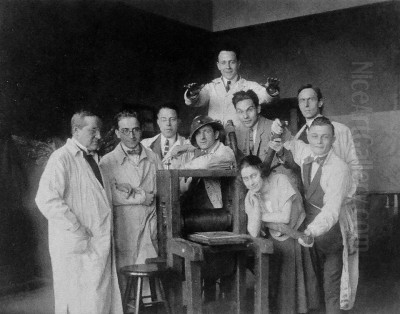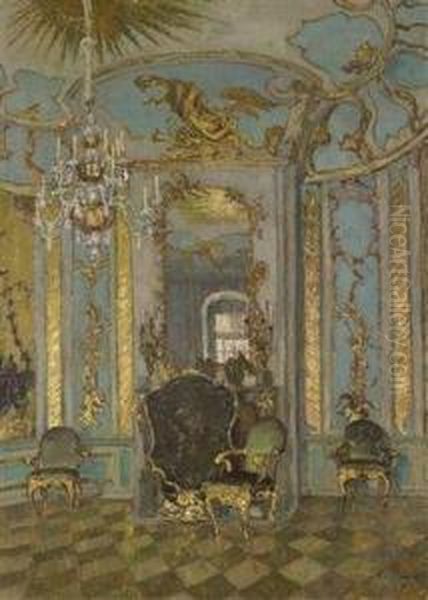
August von Brandis stands as a notable figure in German art history, particularly recognized for his evocative interior scenes and his association with the Impressionist movement in Germany. Born in 1859 and passing away in 1947, his career spanned a period of significant artistic change. While perhaps not as globally renowned as some of his contemporaries, Brandis carved a distinct niche for himself through his sensitive portrayal of light, space, and domestic tranquility, alongside contributions as a portraitist, printmaker, and educator. His journey from aspiring medical student to respected artist and professor reveals a dedicated pursuit of his true calling.
Early Life and Artistic Awakening
August Friedrich Karl von Brandis was born in 1859, reportedly in Halle an der Saale, though some sources mention Haselhorst near Berlin, which was then part of Prussia (now Germany). His early academic path initially pointed towards a different career altogether. He commenced studies in medicine in Berlin, a rigorous field demanding precision and observation – qualities that would later serve him well in his artistic endeavors. However, the allure of the visual arts proved stronger than that of medicine.
Making a decisive shift, Brandis abandoned his medical studies to pursue painting. This was a significant step, moving from the sciences to the arts, indicating a profound personal commitment to artistic expression. His formal art education took place under the tutelage of respected figures within the German art establishment. He studied with Anton von Werner, a prominent history painter and influential director of the Berlin Academy of Arts, known for his large-scale historical and allegorical works, often imbued with a sense of national pride.
Brandis also studied under Hugo Vogel, another artist associated with historical themes and portraiture, who also taught at the Berlin Academy. Training under such masters would have provided Brandis with a strong foundation in academic drawing, composition, and technique, typical of late 19th-century art education in Germany. This traditional grounding likely informed his later work, even as he embraced more modern stylistic influences.
Development of an Artistic Voice: From Religion to Interiors

Like many artists trained in an academic setting during that era, Brandis's early work reportedly included religious themes. This was a common subject area, offering opportunities to explore complex compositions, human emotion, and established iconographies. However, his artistic focus evolved significantly over time. He gradually moved away from grand historical or religious narratives towards more intimate and personal subjects.
His mature style became increasingly associated with interior scenes, still lifes, and floral compositions. It was in these genres that Brandis truly found his voice. He developed a remarkable ability to capture the atmosphere of rooms, often depicting elegant domestic spaces bathed in natural light filtering through windows. These interiors were not merely architectural renderings; they were imbued with a sense of quietude, warmth, and lived experience. He paid close attention to the play of light on surfaces – polished wood, textiles, ceramics – revealing a sensitivity akin to the Impressionists' interest in transient effects.
Alongside interiors, floral still lifes became a significant part of his oeuvre. Works like Blumenstillleben mit rotem Mohn (Flower Still Life with Red Poppies) showcase his skill in rendering the delicate textures and vibrant colors of flowers, often arranged naturally within the context of an interior setting. These paintings combined decorative appeal with a keen observation of natural forms and the interplay of light and shadow.
Printmaking and Portraiture
Beyond his paintings, August von Brandis was also active as a printmaker and portraitist. His skills extended to techniques like lithography and steel engraving, which allowed for wider dissemination of his work. He produced detailed landscape and architectural views, particularly of regions in western Germany, such as the Rhineland. Works like the steel engraving View from the Drachenfels and a lithograph depicting the Siebengebirge Valley exemplify his precision and ability to capture scenic beauty in graphic media.
These prints often displayed a high degree of realism and meticulous detail, perhaps reflecting his academic training more directly than some of his paintings. They served both as artistic expressions and topographical records, appealing to a market interested in views of picturesque German locations.
His work in portraiture also gained recognition. Notably, he collaborated with the publishers Henry & Cohen in Bonn to create a series of portraits depicting professors from the University of Bonn. One example mentioned is the Portrait of Professor Braunshausen. This commission highlights his standing as a capable portrait artist, trusted to capture the likenesses of respected academic figures. These portraits likely required a blend of accurate representation and insightful characterization.
Brandis and German Impressionism
August von Brandis is frequently categorized as a representative of German Impressionism. This movement, while inspired by its French counterpart, developed its own distinct characteristics in Germany. Key figures often associated with German Impressionism include Max Liebermann, Lovis Corinth, and Max Slevogt. Brandis moved within these circles, and his work shares certain affinities with theirs, particularly the interest in capturing light effects, a looser brushwork in some passages (compared to strict academic finish), and a focus on scenes from everyday life or intimate surroundings.
Compared to the often more radical approach of French Impressionists like Claude Monet or Pierre-Auguste Renoir, German Impressionism, particularly as practiced by artists like Liebermann and Brandis, sometimes retained stronger ties to realism and traditional composition. Brandis's interior scenes, with their careful rendering of space and objects bathed in light, fit well within this context. He explored the nuances of light and color within the contained environment of a room, rather than exclusively focusing on plein-air landscape painting.
His contemporaries included not only the leading Impressionists but also artists exploring other directions. Franz von Stuck, for instance, was a major figure in Symbolism and Jugendstil in Munich, representing a different artistic sensibility focused on mythology and allegory. The realism of Wilhelm Leibl and his circle also formed part of the complex artistic landscape of late 19th-century Germany. Artists like Arnold Böcklin pursued Symbolist themes with a unique intensity, while Hans Thoma offered idyllic, sometimes folk-inspired scenes. Brandis navigated this diverse environment, aligning himself most closely with the Impressionist tendency towards capturing perceived reality and atmosphere through light and color.
Academic Career and Recognition
Brandis's contributions extended beyond his studio practice into the realm of art education. His expertise and growing reputation led to academic appointments. In 1904, he secured a teaching position in Danzig (now Gdańsk, Poland), which was then a significant Prussian city. This role would have involved instructing students in drawing and painting, passing on the skills and knowledge he had acquired.
A few years later, in 1909, he moved to Aachen, a city with a rich history in western Germany. There, he took up a prestigious position as a lecturer (Dozent) at the Faculty of Architecture at the RWTH Aachen University (Technische Hochschule Aachen). Teaching figural drawing and landscape painting within an architecture faculty suggests an appreciation for the foundational importance of artistic skills for architects, focusing on observation, representation, and potentially the integration of art with architectural spaces. This long-term academic role indicates that he was a respected educator as well as a practicing artist.
His work received recognition during his lifetime. The publication of his portraits and landscape prints attests to a contemporary market for his art. His paintings, such as Gobelsaal (Gobelin Hall or Tapestry Room) and the aforementioned floral still lifes, were exhibited and collected. The fact that his works appear in auction records and art historical literature confirms his established place within the German art scene of his time. He was considered an important painter, particularly noted for his specialization in interior subjects.
Notable Works: A Closer Look
Several specific works help illustrate the range and focus of August von Brandis's art:
Gobelsaal (Gobelin Hall/Tapestry Room): This title suggests an interior scene featuring prominent tapestries. Such subjects allowed artists to explore rich textures, complex patterns, and the interplay of light within a grand or historical domestic setting. It likely showcases his skill in rendering detailed interiors and creating a specific mood.
Blumenstillleben mit rotem Mohn (Flower Still Life with Red Poppies): Representative of his work in floral still life, this painting would focus on the vibrant color and delicate forms of poppies, likely set within an interior context that complements the arrangement. It highlights his interest in natural beauty and the decorative qualities of flowers.
View from the Drachenfels (Steel Engraving): This print depicts a famous viewpoint in the Siebengebirge mountain range along the Rhine River. As a steel engraving, it would emphasize fine lines and details, capturing the panoramic landscape with precision, characteristic of topographical prints popular in the 19th century.
Siebengebirge Valley (Lithograph): Similar to the Drachenfels view, this lithograph would portray the scenic beauty of the Siebengebirge region. Lithography allows for softer tonal variations than steel engraving, potentially offering a different atmospheric quality while still focusing on representational accuracy.
Portrait of Professor Braunshausen (Series): Part of his commissioned work for the University of Bonn, these portraits demonstrate his ability in capturing likeness and character, fulfilling the formal requirements of academic portraiture.
These examples underscore Brandis's versatility across painting and printmaking, and his thematic concentration on interiors, still life, landscape, and portraiture.
Legacy and Historical Evaluation
August von Brandis occupies a solid, if perhaps secondary, position in the canon of German art history. He is primarily remembered as a skilled painter of interiors, admired for his ability to capture the subtle effects of light and atmosphere within domestic spaces. His association with German Impressionism places him within a key movement that bridged 19th-century realism and the burgeoning modernism of the early 20th century.
His work provides valuable insight into the tastes and aesthetics of the German bourgeoisie during the late Wilhelmine era and beyond. His depictions of comfortable, well-lit interiors reflect a sense of order, tranquility, and appreciation for domestic life. While not radically innovative in the vein of the Expressionists who followed, Brandis excelled within his chosen genres, creating works of enduring charm and technical proficiency.
His dual role as a practicing artist and a long-serving university lecturer also contributed to his influence, shaping the skills and perceptions of students, particularly those in architecture who benefited from his instruction in drawing and painting. His printmaking activities further broadened the reach of his art.
In summary, August von Brandis was a dedicated and talented German artist whose career successfully navigated the transition from academic training to an engagement with Impressionist ideas. His legacy rests primarily on his beautifully rendered interior scenes and still lifes, which capture moments of quiet beauty and domestic peace, alongside his contributions as a portraitist, printmaker, and respected educator within the German art world of his time. He remains a figure worthy of attention for his consistent quality and his specific contribution to the rich tapestry of German art around the turn of the 20th century.